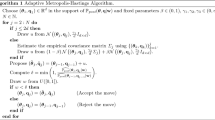Abstract
Inverse-dispersion calculations can be used to infer atmospheric emission rates through a combination of downwind gas concentrations and dispersion model predictions. With multiple concentration sensors downwind of a compound source (whose component positions are known) it is possible to calculate the component emissions. With this in mind, a field experiment was conducted to examine the feasibility of such multi-source inferences, using four synthetic area sources and eight concentration sensors arranged in different configurations. Multi-source problems tend to be mathematically ill-conditioned, as expressed by the condition number κ. In our most successful configuration (average κ = 4.2) the total emissions from all sources were deduced to within 10% on average, while component emissions were deduced to within 50%. In our least successful configuration (average κ = 91) the total emissions were calculated to within only 50%, and component calculations were highly inaccurate. Our study indicates that the most accurate multi-source inferences will occur if each sensor is influenced by only a single source. A “progressive” layout is the next best: one sensor is positioned to “see” only one source, the next sensor is placed to see the first source and another, a third sensor is placed to see the previous two plus a third, and so on. When it is not possible to isolate any sources κ is large and the accuracy of a multi-source inference is doubtful.
Similar content being viewed by others
References
Crenna BP, Flesch TK, Wilson JD (2008) Influence of source–sensor geometry on multi-source emission rate estimates. Atmos Environ 42: 7373–7383
Dyer AJ (1974) A review of flux–profile relationships. Boundary-Layer Meteorol 7: 363–372
Flesch TK, Wilson JD (2005) Estimating tracer emissions with a backward Lagrangian stochastic technique. In: Hatfield JL, Baker JM (eds) Micrometeorology in agricultural systems. American Society of Agronomy, Madison, pp 513–531
Flesch TK, Wilson JD, Harper LA, Crenna BP, Sharpe RR (2004) Deducing ground-air emissions from observed trace gas concentrations: a field trial. J Appl Meteorol 43: 487–502
Garratt JR (1992) The atmospheric boundary layer. Cambridge University Press, UK, p 316
Gerald CF, Wheatley PO (1984) Applied numerical analysis. Addison-Wesley Publishing, Reading, p 579
Harper LA, Flesch TK, Powell JM, Coblentz WK, Jokela WE, Martin NP (2009) Ammonia emissions from dairy production in Wisconsin. J Dairy Sci 92: 2326–2337
Kaimal JC, Finnigan JJ (1994) Atmospheric boundary layer flows: their structure and measurement. Oxford University Press, UK, p 289
McBain MC, Desjardins RL (2005) The evaluation of a backward Lagrangian stochastic (bLS) model to estimate greenhouse gas emissions from agricultural sources using a synthetic tracer source. Agric For Meteorol 135: 61–72
McInnes KJ, Kissel DE, Kanemasu ET (1985) Estimating ammonia flux: a comparison between the integrated horizontal flux method and theoretical solutions of the diffusion profile. Agron J 77: 884–889
Paulson CA (1970) The mathematical representation of wind speed and temperature profiles in the unstable atmospheric surface layer. J Appl Meteorol 9: 857–861
Press WH, Teukolsky SA, Vetterling WT, Flannery BP (2007) Numerical receipts: the art of scientific computing. Cambridge University Press, UK, p 1235
Pudykiewicz JA (1998) Application of adjoint tracer transport equations for evaluating source parameters. Atmos Environ 32: 3039–3050
Seibert P, Frank A (2004) Source–receptor matrix calculation with a Lagrangian particle dispersion model in backward mode. Atmos Chem Phys 4: 51–63
Stewart GW (1996) Afternotes on numerical analysis. Society for Industrial and Applied Mathematics, Philadelphia, p 200
Su F, Shao M, Cai X, Zeng L, Zhu T (2003) Estimates of methane emissions in Beijing using a backward trajectory inversion model. Chem Speciat Bioavailab 14: 43–48
Thomson LC, Hirst B, Gibson G, Gillespie S, Jonathan P, Skeldon KD, Padgett MJ (2007) An improved algorithm for locating a gas source using inverse methods. Atmos Environ 41: 1128–1134
Wilson JD, Thurtell GW, Kidd GE, Beauchamp EG (1982) Estimation of the rate of gaseous mass transfer from a surface source plot to the atmosphere. Atmos Environ 16: 1861–1867
Yee E (2008) Theory for reconstruction of an unknown number of contaminant sources using probabilistic inference. Boundary-Layer Meteorol 127: 359–394
Author information
Authors and Affiliations
Corresponding author
Rights and permissions
About this article
Cite this article
Flesch, T.K., Harper, L.A., Desjardins, R.L. et al. Multi-Source Emission Determination Using an Inverse-Dispersion Technique. Boundary-Layer Meteorol 132, 11–30 (2009). https://doi.org/10.1007/s10546-009-9387-1
Received:
Accepted:
Published:
Issue Date:
DOI: https://doi.org/10.1007/s10546-009-9387-1




